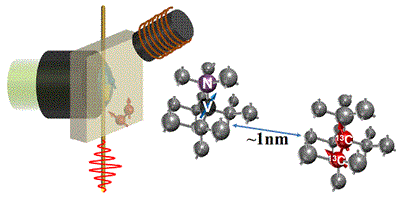News resource:
http://en.physics.ustc.edu.cn/news_10/News/201312/t20131212_179478.html
Atomic-scale Structure Analysis of Single Nuclear Spin Clusters using Magnetic Resonance
Prof. DU Jiangfeng's group, USTC with their collaborators recently succeeds in sensing and atomic-scale analysis of single nuclear spin clusters in diamond at room temperature via quantum interferometer. This work was advanced online published in journal Nature Physics on Nov. 24.[Nature Physics, AOP: 24 Nov. 2013, DOI: 10.1038/NPHYS2814].
Traditional spin-magnetic resonance has been widely used in scientific research and medical fields and the test targets are ensemble samples containing billions of identical spins. In recent years spin magnetic resonance advances from the statistical average of ensemble sample method to direct measuring of single quantum state information, a further step towards the ultimate goal of understanding the properties of matter by compositional, structural, and dynamical analysis in atomic scale. However, subject to traditional magnetic resonance technology, single-molecule nuclear magnetic resonance is still a challenge in the field of magnetic resonance spectroscopy.
Du's research group and their collaborators sense a single 13C-13C nuclear spin dimer located about 1 nm from the NV center and characterize the interaction (~ 690Hz) between the two nuclear spins. Through decoherence measurements of nitrogen-vacancy (NV) centers under dynamical decoupling control the weak magnetic signals generated from the spin system are converted to phases of interferometer. From the measured interaction they derive the spatial configuration of the dimer with atomic-scale resolution, a direct measurement of the interactions within single nuclear spin clusters. The referees remark the work as “a highly original, novel, and interesting”. "The authors use dynamic-decoupling techniques for the measurement. The results are significant, and will be useful to workers in the field.”[Nature Physics, DOI: 10.1038/NPHYS2814].

Figure 1Schematic of the set-up and experimental method. /Image by Spin Magnetic Resonance Lab

Figure 2 Artistic exhibition of a single bonded 13C-13C nuclear spin dimer detected by Nitrogen-Vacancy (NV) probe (marked by shining spot)./ Image by Spin Magnetic Resonance Lab
Earlier before, cooperating with German and American research groups, Prof. Du's team succeeds in sensing of (5nm)3 hydrogen nuclear spin sample, a breakthrough in micro scale NMR technology. This work has been published in journal Science on February 1st, 2013. [Science 339, 561 (2013)], receiving high evaluation for, as quoted, “use of diamond-based nanomagnetometer reduces the detection volume of MRI to the level of individual protein molecules”. [Philip Hemmer, Science 339, 529 (2013)].
These results indicate that, in combination with advanced material-surface engineering, central spin decoherence under dynamical decoupling control may be a useful probe for NMR single-molecule structure analysis, thus provide insights for micro-scale research in physics, biology and other fields.
(RUI Ying, School of Physical Sciences)